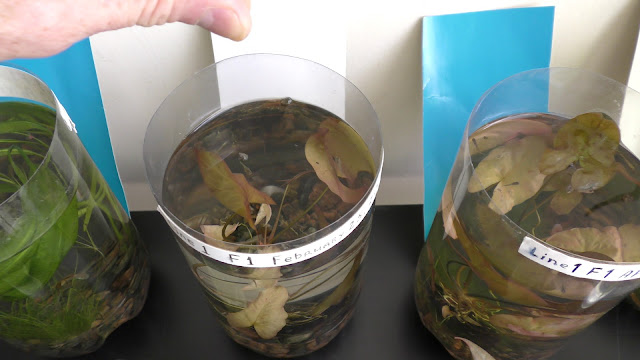Here are some of my aquariums.
I like to call them nurseries.
Most of them are made from 2 liter plastic bottles.
I feed my guppies every morning with fish flakes.
Serve enough for fish to eat in about 2-3 minutes.
Serve a second flake meal after sundown, only in aquariums with pregnant females.
Fish also eat leftovers that sink to the bottom of aquariums, plants, and any little water creatures they can catch.
Oxygen gets into water through water to air surface exchange and from plants in the water.
I stopped using an air pump.
All aquariums are populated with 2 or more types of plants.
All nurseries are populated with seed shrimps and cyclopes weeks before I move fish in it.
Guppies eat them.
I add seed shrimps and cyclopes every couple weeks to keep their population up in all aquariums. This is my smallest nursery where I breed seed shrimps.
Use a pipette to transfer at least 5-6 of them at a time.
Release them at the bottom of an aquarium - otherwise fish may eat them right away.
Make dechlorinated water by keeping tap water in an open jar at least overnight.
Add dechlorinated water to maintain the level in aquariums at least once a week as it evaporates.
Have an open jar of dechlorinated water available everyday.
Use a toothbrush to remove algae build up from walls of aquariums when you first notice it.
Control growth of algae as described in a previously published video.
Changing water in an aquarium means adjusting water quality.
The desirable water quality can be achieved in different ways.
Adding water as it evaporates, using plants to remove nitrites and produce oxygen, adjusting light to affect growth of plants (including algae) are just a few ways to change water quality.
Draining water from the bottom of an aquarium to remove remains of organic (primary remains of fish food and fish poop) is a common way of changing water.
The last time I drained water from the bottom of this aquarium was on April 7th, 2017.
This is my oldest (and largest) couple of guppies.
They poop much more compared to smaller size babies, which I keep in other aquariums.
Nevertheless, the cleaning crew made up of little water bugs keeps this, and all other aquariums, visibly fish poop free.
The mentioned water creatures and bacteria degrade organic remains.
They don't remove it completely.
Over a longer period of time, it may tip the balance of aquarium ecosystem.
Then draining water from an aquarium may be necessary.
Respond at first notice to any changes in fish behavior, water cloudiness or discoloration (greenish or brownish algae), stale water odor and any other abnormalities.
In the past, I drain up to 20% of water from any aquarium.
Changing a larger quantity of water could be stressful for guppies.
Let's see how much and what kind of "dirt" has accumulated in about 6 weeks period of time.
This much accounts for a job well done by my tiny cleaning crew :)
Stir the water.
Watch for anything moving against the current.
Those are seed shrimps, cyclopes and etc.
They can grow larger.
Drop them back to the aquarium.
Add dechlorinated water to the level in the aquarium.
Once again, I did not drain water from this aquarium for 6 weeks.
Other aquariums populated with younger and smaller guppies.
I did not drain water from those aquariums up to 5 months as of this video recording.
Here is one of the nurseries from which I add seed shrimps and cyclopes to aquariums populated with fish.
I have prepared this and similar nurseries for different projects and as the last resort.
Moving fish to a nursery aquarium from a problematic aquarium is simple and a fast way to resolve any problem.
It is my plan for an emergency, that I hope will never come.
Here, you can see more of my aquariums.
That is how I usually keep them.
The small cup size nurseries are only for plants, seed shrimps, and such creatures.
The size of my aquariums has allowed me to move them around as necessary to adjust exposure to sun light.
I have been using the described method of fish care without artificial filters or air pumps since the beginning of 2017.
I don't know how well it may work in the longer term or if it can be scaled to larger size aquariums.
It works very well for me at least until the moment of publication of this video.
Every aquarium has a different ecosystem.
Constant daily observations are the key of understanding, creating, and keeping naturally balanced ecosystems.
Have fun and happy aquariums :)



















































Amazing, keep up the good work. Mother nature (mom) loves what your doing!!!
ReplyDelete